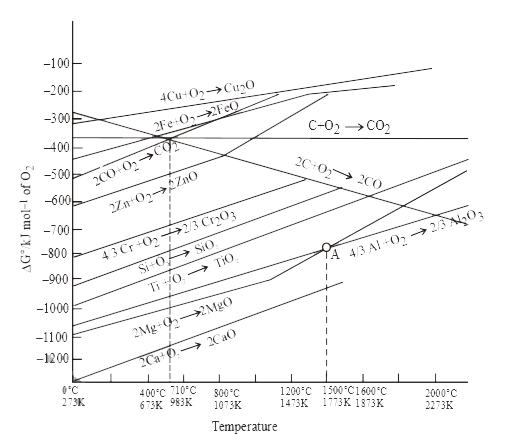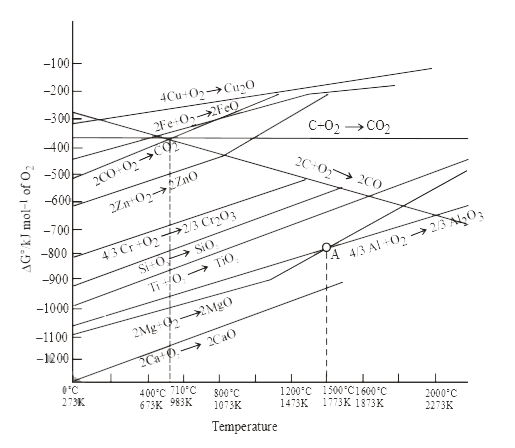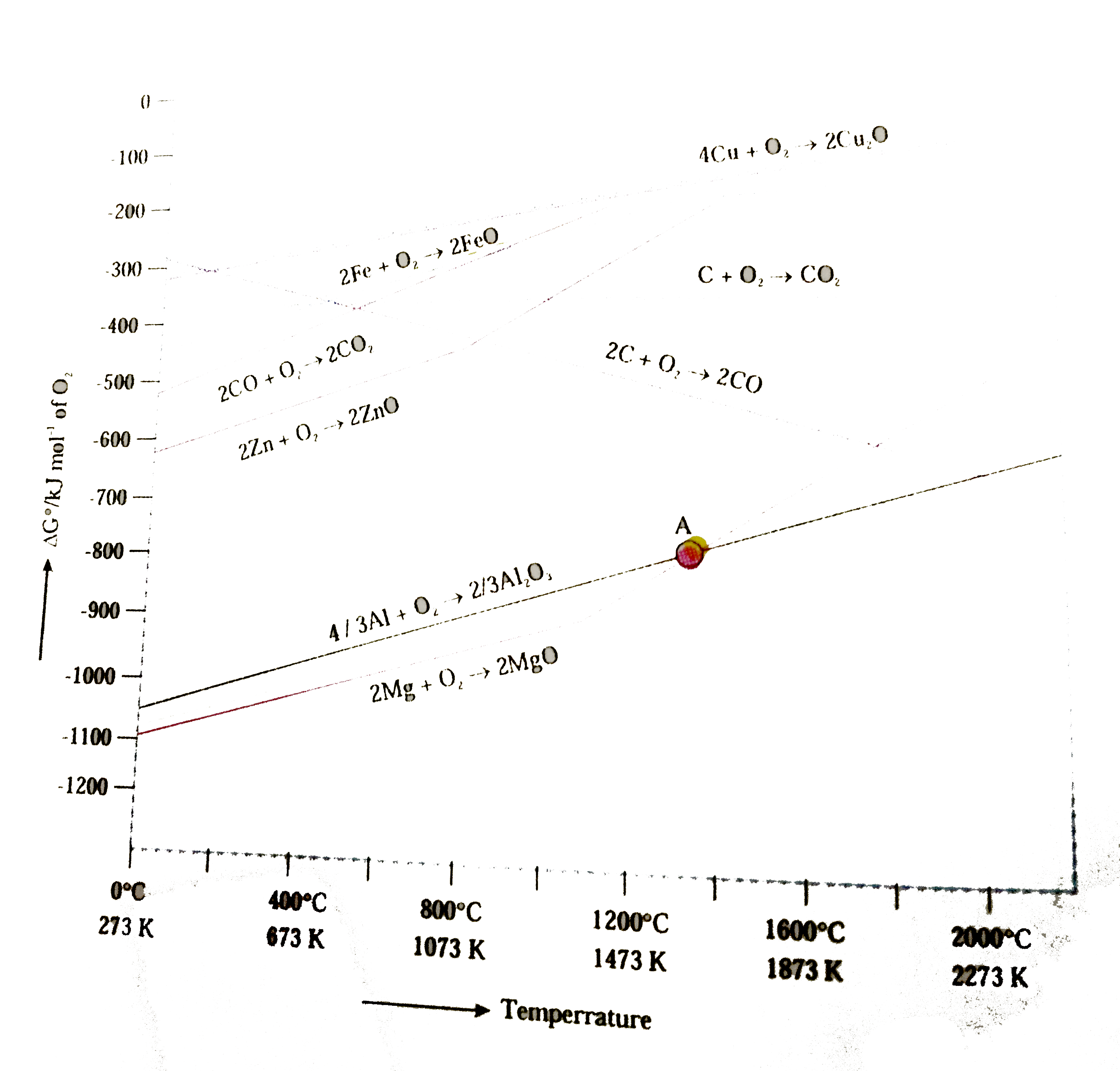The Elingham diagram (Fig.) represents the formation of oxides of several metals together with oxides of C(i.e., CO and CO2 ). The diagram is not to scale yet it can help in making a lot of predictions.

Which is the chief reducing agent if the carbon reduction of iron oxides is carried out below 710∘C ?
CO
C
Either C or CO
Cannot be predicted on the basis of given information.
The correct Answer is:A
Step by step video, text & image solution for The Elingham diagram (Fig.) represents the formation of oxides of several metals together with oxides of C(i.e., CO and CO_2 ). The diagram is not to scale yet it can help in making a lot of predictions. Which is the chief reducing agent if the carbon reduction of iron oxides is carried out below 710^@C ? by Chemistry experts to help you in doubts & scoring excellent marks in Class 12 exams.
Topper's Solved these Questions
- BOOK - MOTIONCHAPTER - METALLURGYEXERCISE - EXERCISE 2 (LEVEL - I)70videos
METALLURGY
- BOOK - MOTIONCHAPTER - METALLURGYEXERCISE - EXERCISE 2 (LEVEL - II)37videos
METALLURGY
- BOOK - MOTIONCHAPTER - METALLURGYEXERCISE - EXERCISE 4 (LEVEL - II)17videos
METALLURGY
- BOOK - MOTIONCHAPTER - LIQUID SOLUTIONEXERCISE - EXERCISE-4 (Level-II) PREVIOUS YEAR JEE ADVANCED19videos
LIQUID SOLUTION
- BOOK - MOTIONCHAPTER - MOLE CONCEPTEXERCISE - EXERCISE - 4 LEVEL - II13videos
MOLE CONCEPT
Similar Questions
Knowledge Check
- Question 1 - Select One
The Elingham diagram (Fig.) represents the formation of oxides of several metals together with oxides of C(i.e., CO and CO2 ). The diagram is not to scale yet it can help in making a lot of predictions.

Which of following statements is incorrect?ASi cannot reduce MgO at allBAl can reduce MgO at above 1500∘CCAl can reduce Cr2O3 as well as TiO2DAl cannot reduce ZnO but Mg can reduce ZnO. - Question 2 - Select One
Consider the following statements related to Ellingham diagram
I it consists of plots of formation of oxides of elements
2xM(s)+O2(g)→2MxO(s)
II Each plot is a straight line No effect of change in phase
III In an ellingham diagram the plots of ΔG for oxidation of common metals and some reducing agents are given
Which of these statement are correct?AI and IIBII and IIICI and IIIDAll of the above - Question 3 - Select One
The choice of reducing agent for metal oxide is decided by thermodynamic principles of metallurgy. ΔG must be negative. Ellingham diagram is a plot of ΔfG0 vs T for the formation of oxides of various elements. All the plots slope upwards when temperature increases. Each plot is a straight line except when some change in phase takes place. A metal will reduce the oxide of other metals which lie above it in this diagram.
At a temperature below 1623 K. Al cannot reduceAFeOBCrOCMgODNiO
Determining the directiom of spontaneity from electrode potNa+(aq.)+e−→Na(s)E∘=−2.71Ventials : Predict from Table 3.1, whether Pb2+(aq.) can oxidize Al(s) or Cu(s) under standard conditions. Calculate Eɵ for each reaction at 25∘C.
Strategy: To predict whether a redox reaction is spontaneous, remember that an oxidizing agent can oxidize any reducing agent that lies below it in the table but can't oxidize one that lies above it.
Alternatively, write the expected reaction. Find the oxidizing agents in the equations, one is on the left side and the other on the right side. Locate these oxidizing agents in a table of electrode potentials (the oxidizing agent is on the left side of the reduction half-reaction). The stronger oxidizing agent is the one involved in the half-reaction with the more positive standard electrode potential.View SolutionThe formation of the oxide MxOyper mole of O2 cinsumed is written a 2xyM(S)+O2(g)→2yMxOy the free energy change of the reaction is given by ?G=?H-T?S.
if the ethalpychange?H and ethropy change ?S are assumed to be indendent of temperature the plot of ?G versus T is liner such as shown in th efollowing figure known as Ellingham diagram Figure known a sEllingham diagram Figure is widely used to discuss th priciple ionvolves in the extraction of metal from its oxide.
chorose correct statement from from the following
(I) For the reducation of by 'c' [to be spontaneous ]
(II) DEcreasng ease of reduction of metal oxides by carbon is
(III) Decreasding ease of reduction of metal oxides by caron is
(IV) Resduction of by Al possible at all temperaturesView SolutionThe formation of the oxide MxOyper mole of O2 cinsumed is written a 2xyM(S)+O2(g)→2yMxOy the free energy change of the reaction is given by ?G=?H-T?S.
if the ethalpychange?H and ethropy change ?S are assumed to be indendent of temperature the plot of ?G versus T is liner such as shown in th efollowing figure known as Ellingham diagram Figure known a sEllingham diagram Figure is widely used to discuss th priciple ionvolves in the extraction of metal from its oxide.
chorose correct statement from from the following
(I) For the reducation of by 'c' [to be spontaneous ]
(II) DEcreasng ease of reduction of metal oxides by carbon is
(III) Decreasding ease of reduction of metal oxides by caron is
(IV) Resduction of by Al possible at all temperaturesView SolutionMetals are extracted from their ores by a wide variety of techniques. The most common ores are oxides. Most metals are obtained by direct treatment of theirs ores with chemical agents, but the extraction of certain others require electrolysis. An example of the former type of process is the extraction of iron from its oxide, described by the following equation :
Fe2O3+3C→2Fe+3CO
The relative ease of extraction of a metal from its oxide can be estimated using the Ellingham diagram, as shown in the figure.
The diagram plots the free energies of formation of various oxides per mole of consumed oxygen as a function of absolute temperature.
FIITJ∃CHEMB04_C02E07009_Q01.png width=80%><br>Whenferric⊗isreduced→obta∈ironmηl,CO_(2)orCOcanbe∏uced.The∏uctionofCO_(2)View SolutionMetals are extracted from their ores by a wide variety of techniques. The most common ores are oxides. Most metals are obtained by direct treatment of theirs ores with chemical agents, but the extraction of certain others require electrolysis. An example of the former type of process is the extraction of iron from its oxide, described by the following equation :
Fe2O3+3C→2Fe+3CO
The relative ease of extraction of a metal from its oxide can be estimated using the Ellingham diagram, as shown in the figure.
The diagram plots the free energies of formation of various oxides per mole of consumed oxygen as a function of absolute temperature.

Which of the following best explains why the free energy of formation of Fe2O3 becomes less negative as the temperature is increased.View Solution
